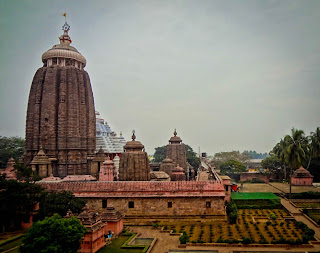Achleshwar
Mahadev Temple, Achalgarh, Mount Abu, Rajasthan, India
Location
Achaleshwar Mahadev Temple is located just outside the Achalgarh Fort in the village, Achalgarh, 11km away from Mount Abu towards north. Mount Abu is a famous place and the only Hill station of Rajasthan in Sirohi District.
 |
| Achaleshwar Mahadev Temple |
 |
| Nandi made of Brass |
Legend
According to a legend the temple is contructed around the footprints of Lord Shiva on a rock as foundation. Generally, the Lingam of Lord Shiva is worshiped, but this is the only place on earth where the Toe is worshiped.
A huge brass structure of Divine Nandi Bull along with two large Buffaloes (made of large stone) is installed in front of the temple. When the Muslim invaders came here and attack the temple, millions of bumble bees released by Nandi, attacked on them and forced to fled away from the Temple.
Mount Abu is an important place of Hindu religion. There are 108 Temples of Lord Shiva in and around Mount Abu. After Varanasi it is supposed to be the another abode of Lord Shiva and 33 crores of God and Goddesses in the Universe ( as per Hindu mythology ). There is a beautiful lake nearby named Mandakini, surrounded by rocky hills on which the images of buffaloes and the King are carved beautifuly.
 |
| Mandakini Lake |
In Garbhagriha (Sanctum), there is a semi circular pit in which the image of Right Toe of Lord Shiva can be seen and the water offered there on Shivalingam disappears. It is still a mystery, where the water goes. Devotees believe that the water goes to netherworld (Patal lok).
 |
| Semicircular pit |
In the courtyard of the temple, a big, old and ancient tree of Champa flower which indicate towards the ancientness of this place. On the left side of the temple,there is a DHARAMKANTA ( Religious Weighing Balance ) built over the two artistically constructed, beautiful pillers. It is a tradition that the King, taking over the charge, first receive the blessings of Achleshwar Mahadev and then sit over Dharmakanta and take a oath of being impartial to the people of his territory.
Around the campus, there are also many more temples, constructed in which idols of black stones are installed. They are namely Varah Narsingham, Baman Bhagwan, Kachhap, Matsya, Rama, Krishna, Budhha, Kalangi Awatar are installed. There are also many sculpted idol which are made of Crystal like stone. In natural light this stone looks opaque but if you place a candle behind the idol a beautiful crystal like sparkle can be seen.The stone is called SPHATIK in Hindi.
About the Temple
After the attack of the Muslim invaders, the then incharge of the temple began to think some way to protect the temple from the enemies in future.
He chalk out a plan to protect the sanctity of the temple by a simple method and decided to cover it by a layer of lime over the temple. This process covered the intricate fine filigree, important inscriptions and other art work under the layer of lime. As a result the appearance of the temple became very ordinary and insignificant.
Some where in 1979, the Prince of Sirohi visited this temple with the royal visitors and saw some thing looking like marble under the layer of lime at one place on the wall of the temple. Then the
Prince decided to restore the original glamour of the temple. At first he appointed the artisans for this work. They started to remove the layers of lime with extreme precautions. After that the great glory of temple was being revealed.
The semicircular pit of Garbhagriha (Sanctum) was originally built of blocks of marble. The Sanctum was rebuilt with excellent quality of marble slab. After reconstruction a space for parikrama came out inside the temple.
After restoration the Dashawatar temple left all the visitors spell bound.
Places to visit nearby
Delwara Jain Temple
The temple is situated about 2.5 km from main city in the village Delwara. It is an ancient temple
of the period 1513 CE. The artistic work inside the temple is beautiful and unparalleled. One should must visit.
 |
| Delwara Jain Temple |
Adhar Devi Temple
This temple is situated in a cave and (dedicated to Goddess Durga) about 3 km away from the main town of Mount Abu. There are 365 stairs from the ground level upto the temple.
 |
| Adhar Devi Temple |
Achalgarh Fort
Achalgarh Fort is situuated 11 km away to north of Mount Abu. The fort was originally built by Parmar Dynasty. Later on it was renovated, reconstructed and named as Achalgarh fort by Maharana Kumbha in 1442 CE. The fort is historical and of religious importance and worth visit.
 |
| Achalgarh Fort |
Brahmakumari's
Prajapita Brahmakumari Ishwariya Vishawavidyalaya is an International Non Govt. Organisation head quartered at Mount Abu. It is a spiritual institution focused on self transformation.
 |
| Brahmakumari Vishwavidyalaya |
Where To Stay
Mount Abu is the popular hill station and pilgrim destination. There are so many hotels of every budget are available here.
Budget Hotels - Hotel Lake Palace, Hotel Savera Palace, Hotel Sikhar, Aranya Village Resort etc.
Star Hotels - Hotel Hillock, Hotel Chacha Inn,Hotel Sunset etc
There are so many Govt. rest house, available for comfortable stay.
How To Reach
By Air
Maharana Pratap Udaipur is the nearest Airport, 207 km away. One can reach by his own car or taxi.
By Rail
Abu Road is the nearest Railway Station on Mumbai - Delhi route.
By Road
Mount Abu is well connected by road to major towns of northern and western India.The distance from some important cities are - Ahmedabad - 222 km, Jodhpur - 225 km, Jaipur - 509 km. It is advised not to travel in night.
Video
Video




































